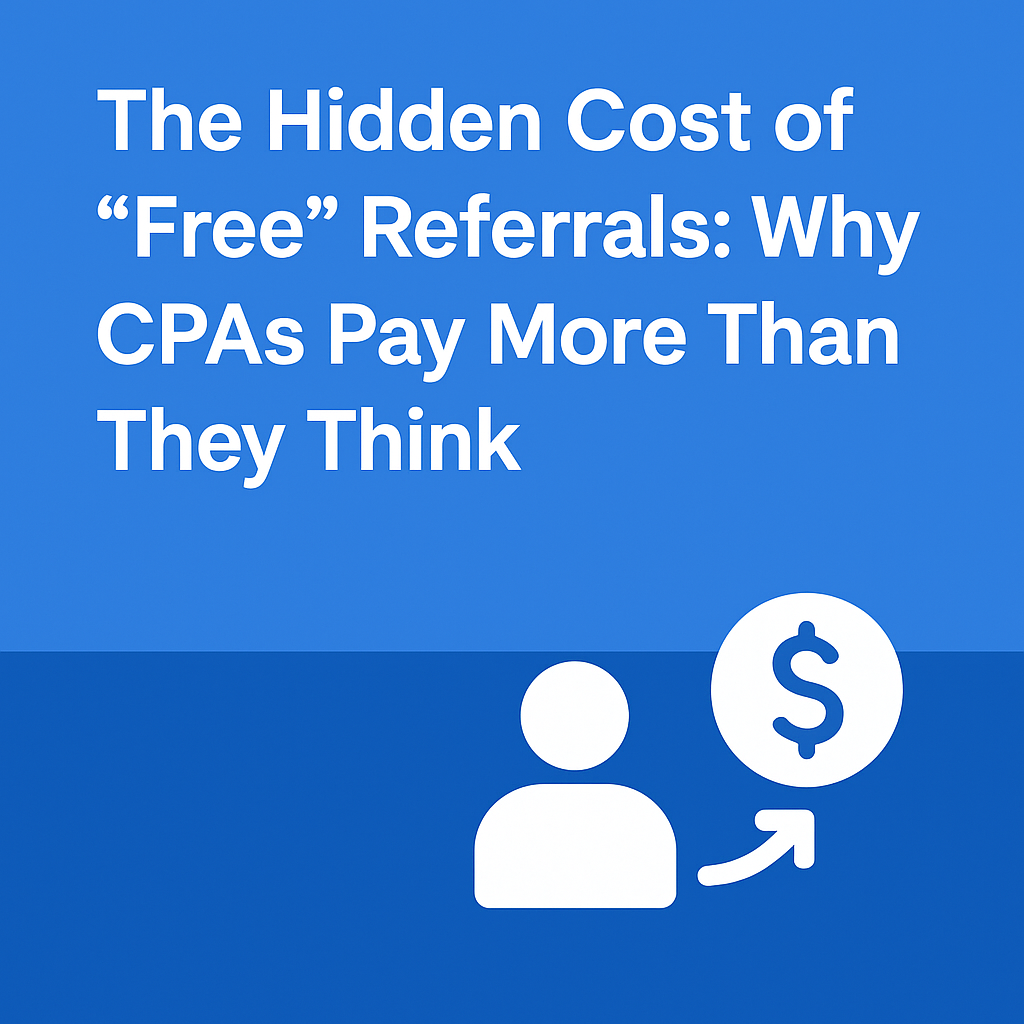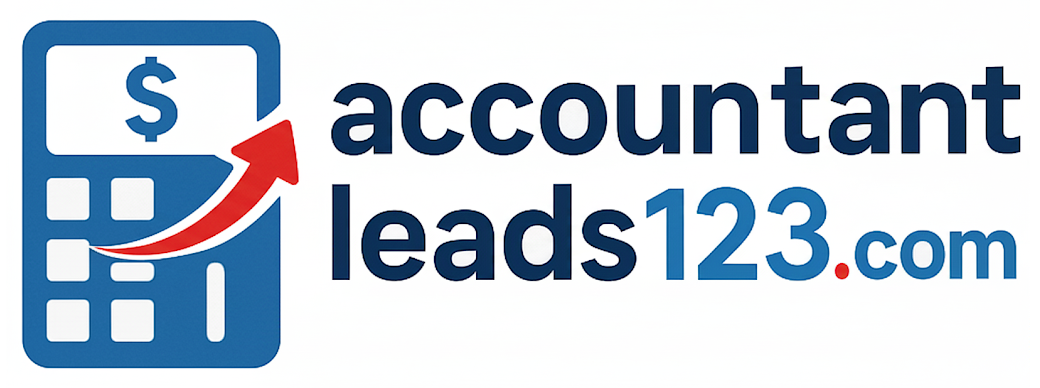The Hidden Cost of ‘Free’ Referrals: Why CPAs Pay More Than They Think
The Hidden Cost of ‘Free’ Referrals: Why CPAs Pay More Than They Think
By admin | September 16, 2025 | 0
Most accounting firms believe referrals are free. After all, you’re not paying Google ads, hiring business development reps, or investing in marketing automation. A satisfied client mentions your name, someone calls, you close the deal. What could be cheaper?
The reality is more complex. Referrals aren’t free. They’re expensive in ways most CPAs never calculate, and this hidden cost structure is quietly limiting growth across the accounting industry.
The Mathematics of “Free” Referrals
Let’s break down what referral dependency actually costs a typical $3M accounting firm:
Current State Analysis:
- Monthly referrals received: 8-10
- Conversion rate: 40%
- New clients per month: 3-4
- Average client value: $18,000
- Monthly new revenue: $54,000-$72,000
Seems healthy, right? Now let’s calculate the hidden costs.
Hidden Cost #1: Opportunity Cost of Limited Market Reach
Your referral network represents roughly 2-5% of your total addressable market. In a mid-size city with 30,000 businesses, your referral sources might reach 600-1,500 potential prospects. The other 28,500+ businesses will never hear about you through referrals, no matter how exceptional your service.
Hidden cost: 95% of your market remains inaccessible through referrals alone.
Hidden Cost #2: Revenue Unpredictability
Referral-dependent firms experience 30-50% monthly revenue swings based on factors completely outside their control:
- Economic downturns make referral sources conservative
- Client industry problems reduce referral volume
- Seasonal business cycles affect recommendation timing
- Key referral sources retire, relocate, or change jobs
Case Study: A $2.5M firm in Phoenix saw referrals drop 60% when their largest referral source (a major real estate broker) reduced operations during the 2022 housing market correction. Revenue planning became impossible.
Hidden cost: Inability to forecast or control growth trajectory.
Hidden Cost #3: The Referral Tax
Every referral comes with implicit obligations:
- Preferential pricing for referral sources
- Priority service during busy seasons
- Reciprocal referral pressure
- Maintaining relationships even with low-value referrers
A firm receiving 100 referrals annually typically spends 15-20 hours monthly on referral relationship maintenance. At partner billing rates of $200-300/hour, that’s $36,000-$72,000 in annual opportunity cost.
Hidden cost: $360-$720 per referral in relationship maintenance time.
Hidden Cost #4: Market Position Weakness
Referral-dependent firms operate from positions of relative weakness:
- No direct prospect relationships before the sales conversation
- Limited ability to influence timing of prospect decisions
- Competing against firms with systematic outreach capabilities
- Reduced pricing power due to referral source expectations
Hidden cost: 10-15% lower average client values compared to firms with systematic lead generation.
The True Cost Calculation
Let’s calculate the real cost of referrals for our example $3M firm:
Annual Referral Investment:
- Relationship maintenance time: $48,000
- Preferential pricing discount: $15,000
- Lost opportunities (limited market reach): $180,000
- Revenue volatility buffer needed: $25,000
Total Annual Hidden Costs: $268,000
Referrals Generated Annually: 100
True Cost Per Referral: $2,680
Suddenly, those “free” referrals cost more than Google ads.
The Competitive Disadvantage Multiplier
The hidden costs compound when competitors adopt systematic lead generation:
Market Share Erosion: Firms with proactive outreach capture prospects before they enter referral networks. Your 30% market share slowly drops to 25%, then 20%.
Pricing Pressure: Systematic competitors can offer competitive pricing because they’re not dependent on referral source relationships.
Growth Velocity Gap: While you generate 3-4 new clients monthly, systematic competitors generate 8-12, compounding their market advantage.
Beyond the Numbers: Strategic Vulnerability
The deepest cost of referral dependency isn’t financial, it’s strategic:
- No Growth Control: You can’t accelerate growth when opportunities arise
- Defensive Positioning: You’re always responding to competitor initiatives
- Succession Risk: Personal referral relationships don’t transfer easily
- Market Evolution: Younger business owners prefer researching providers independently
The Path Forward
Understanding referral costs doesn’t mean abandoning referrals. It means recognizing them as one channel in a diversified growth strategy.
Hybrid Approach Benefits:
- Maintain valuable referral relationships
- Add systematic prospecting for consistent pipeline
- Reduce dependence on any single growth channel
- Create predictable revenue forecasting
Calculate Your Referral Costs
Use this framework to calculate your true cost per referral:
- Relationship Maintenance Hours Monthly: _____ × $250/hour × 12 months
- Preferential Pricing Annual Discount: $_____
- Partner Opportunity Cost: _____ hours monthly × $300/hour × 12 months
- Market Limitation Cost: (Total market size – referral accessible market) × average deal size × 10%
Total Annual Hidden Costs: $_____ Annual Referrals: _____ True Cost Per Referral: $_____
The Bottom Line
Referrals aren’t free. For most accounting firms, the true cost per referral exceeds $2,000-$3,000 when hidden costs are properly calculated.
This doesn’t make referrals bad. It makes them expensive, unpredictable, and strategically limiting when they’re your only growth channel.
The firms thriving in today’s market combine referral relationships with systematic prospecting. They maintain their referral networks while adding predictable, scalable lead generation that reaches the 95% of prospects referrals never touch.
Ready to calculate your true cost per acquisition and compare it to systematic alternatives?
Schedule a free growth assessment to see how your referral costs compare to signals-based marketing ROI.
The mathematics of growth have changed. The question is whether your firm will evolve with them.

